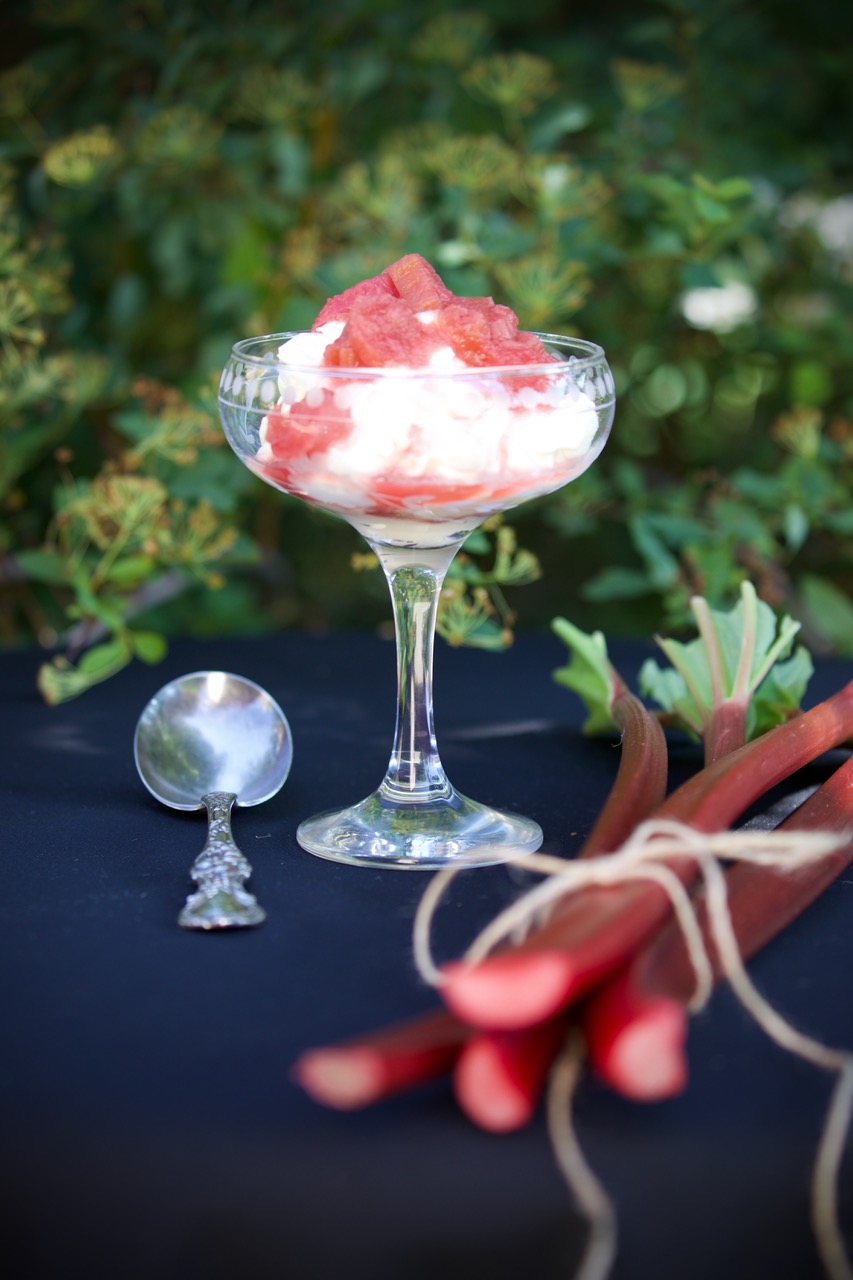There is hardly anything less pretentious than rhubarb. Although the plant is large and somewhat sprawling, it is often found behind barns in old homesteads. It is served up at the tables of country farms in simple dishes like crumbles, jams, and pies. A healthy plant produces deliciousness for at least 10 years with very little attention except for it’s annual treat—a good helping of composed manure. I live in Colorado and can harvest my rhubarb all summer, but you can also find the stalks for sale in grocery stores beginning in the spring.
The stalks are the only edible part of the plant and these resemble celery, except that each spring they emerge sporting a delightfully rosy pink hue and hide under huge leaves. By the way, don’t eat those leaves; they contain several compounds that are not good for you. The crunchy stalks are fine to eat, even raw. Rhubarb has a lip-puckering tartness, so it is most often sweetened with sugar and cooked in desserts. I’ve heard stories of children who spent their summer days on a farm with a cup of sugar in one hand and a raw stalk of rhubarb in the other, dipping and crunching, competing with their siblings for the best pucker face.
The dessert called a fool is also a humble thing, a swirl of crushed fruit and whipped cream dating back to the 15th C. The name fool may have come from the French verb fouler, meaning to crush or press. A fruit fool is a dessert with British origins, similar to an Eton Mess. Early in its history the name of this dessert could be interchanged with another famous English dish—the trifle.
I found a recipe for a variation that sounds more like a trifle to me because it includes a bit of cake-like bread and spices but almost no fruit. It can be found in The Accomplisht Cook by Robert May, 1660:
To make a Norfolk Fool. Take a quart of good thick sweet cream, and set it a boiling in a clean scoured skillet, with some large mace and whole cinnamon; then having boil’d a warm or two take the yolks of five or six eggs dissolved and put to it, being taken from the fire, then take out the cinnamon and mace; the cream being pretty thick, slice a fine manchet into thin slices, as much as will cover the bottom of the dish, pour on the cream on them, and more bread, some two or three times till the dish be full, then trim the dish side with fine carved sippets, and stick it with slic’t dates, scrape on sugar, and cast on red and white biskets.
I don’t know about you, but I would need a modern translation to attempt this recipe! You’ll be happy to know that the recipe included here is easy and contains only a few ingredients. It can be made in about thirty minutes and showcase any kind of soft fruit. Peaches or raspberries would be divine, but don’t pass by the chance to try some humble rhubarb in this dessert. Its tart flavor pairs perfectly with the rich sweetness of the whipped cream, and the soft rose pink color is alluring. While technically not a fruit, rhubarb is definitely favored by English cooks so you’re keeping the tradition of the fool when you serve up the dish. Make this ahead and stash it in the refrigerator in lovely footed glasses so you can serve it to your guests on a hot summer evening. Their first bite will “fool” them into thinking that such a heavenly dessert must have taken all day to create.

Rhubarb Fool for Four
Ingredients for the Rhubarb Compote:
1 lb. rhubarb stalks, trimmed and cut into 1/2 inch slices.
1/3 cup sugar
1/4 cup water
1/4 tsp. nutmeg
1 tsp. vanilla extract
Ingredients for the Whipped Creaminess:
1 cup cold heavy cream
1/4 cup confectioner’s sugar
1/4 cup sour cream or mascarpone
Directions:
1. Put the rhubarb, sugar, water, and nutmeg in a non-reactive saucepan (a steel, glass, or enameled pan) and bring to a boil, stirring constantly. Once the mixture is boiling, turn down the heat and let it cook gently until the rhubarb has softened at bit. This will take about 5 minutes, and some of the rhubarb will have broken down while there is still a chunky texture.
2. Remove the pan from the heat and stir in the vanilla. Now let the mixture cool completely, and then chill. The compote can be prepared up to 2 days in advance.
3. In a chilled bowl, add the cream and confectioner’s sugar. Whip to soft peaks. Add the sour cream and continue to whip briefly until the mixture is combined and smooth, but not stiff.
4. Gently fold most of the rhubarb compote into the whipped cream with just a few turns of a spatula or silicone spoon. It should be only barely combined so you can see ribbons of pink compote streaking through the white cream. Reserve a little bit of the compote for a topping.
5. Spoon the fool into four small footed glasses or other clear glass dessert dishes. Top with a teaspoon or so of the reserved compote. Refrigerate an hour or until ready to serve. This dessert is best made the day it is eaten.
Notes:
As written, the small amount (1/3 cup) of sugar will result in a fairly tart compote, just the way I like it! Taste it while it’s cooking and feel free to add a bit more sugar if you’d like to. Remember that the whipped cream will compliment and blunt the tartness nicely.
The sour cream or mascarpone accomplishes two purposes: it adds a wonderful flavor dimension that I love, and it also stabilizes the whipped cream and prevents the fruit from melting into the peaks you’ve whipped.
Variations on a Theme:
- Try a peach fool made in the same way, using 4 peaches, peeled and cut up, in place of the rhubarb. Add a generous 1/2 teaspoon of powdered ginger in place of the nutmeg in the compote.
- A raspberry fool can be made using 2 cups of fresh raspberries in place of the rhubarb, and cinnamon in place of the nutmeg.
- If you prefer a dairy-free dessert, try whipping coconut cream instead of the heavy cream.
- Decorate the finished dessert with sprigs of mint or even edible flowers for a lovely presentation.
- You can serve the fool as a topping for slices of pound cake, which would result in a dessert quite like a simple trifle.
![]()
The featured images are courtesy of Steve Moon and are used with his kind permission for Cultivating.
Terri Moon is a musician and a lover of Jesus. She delights in playing the music of Bach, growing English roses, baking up a good batch of scones, and all good, true, and beautiful things that point to Him. She has found that the most fulfilling adventures come through collaborating with others, and to that end she and her husband Steve (also a member of The Cultivating Project) serve gladly in their church and also on the leadership team of the Anselm Society. Together they raised four children and are now proud grandparents. Hosting friends in their Colorado home is one of their favorite joint adventures.
Terri holds a master’s degree in violin performance, and has collaborated in many concerts and taught students of all ages for 40 years. Her lifelong passion is the intersection of music, worship, and spiritual formation, and she longs to bring to life the beauty of the Church’s heritage in the arts. Terri currently serves as the Music Director of Holy Trinity Anglican Church in Colorado Springs.
Leave a Reply
A Field Guide to Cultivating ~ Essentials to Cultivating a Whole Life, Rooted in Christ, and Flourishing in Fellowship
Enjoy our gift to you as our Welcome to Cultivating! Discover the purpose of The Cultivating Project, and how you might find a "What, you too?" experience here with this fellowship of makers!


This is just delicious in every way, Terri ~ words, images, and recipe. I’m captivated from the opening line to the tantalizing closing and drawn in. I truly hope there is a cookbook that comes from your beautiful kitchen! It will be my favourite!